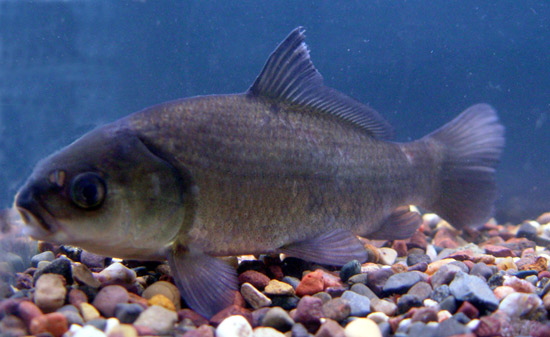
Bigmouth Buffalo
Ictiobus cyprinellus Valenciennes, 1844
member of the Sucker Family (Catostomidae)

photo by Konrad Schmidt
|
|
What's
In a Name? Ictiobus
(Ick-tee-o´-bus) means "bull fish" in Greek |
||
| Where
Do They Live? Bigmouth buffalo used to be much more widespread and abundant in Minnesota than they are today. In the late 1800s and early 1900s, there were countless numbers in our southern lakes, and there were even populations in the upper Mississippi River near Brainerd and Grand Rapids. Bigmouth buffalo are still fairly common in the lower Minnesota, Mississippi, and St. Croix River systems, but they are rare in the Red and Missouri river systems. In the summer of 2001, for the first time in almost 100 years, a bigmouth buffalo was caught in the upper Mississippi River (just below the Blanchard Dam). Bigmouth buffalo live in lowland lakes, sloughs, and big rivers with slow to still waters and bottoms of mud, silt, sand, and gravel. They are especially abundant in flood plain and oxbow lakes. Bigmouth buffalo often are found in association with northern pike, black bullhead, black buffalo, smallmouth buffalo, common carp, freshwater drum, and lake sturgeon. |
|||
|
How
Big Do They Get? |
|||
| What
Do They Eat? This fast growing fish needs a lot of food to keep up with its growth. The bigmouth buffalo competes with many of the fish that is shares a habitat with for the same food items, one example is the common carp. The buffalo eats plankton, copepods, cladocerans, bottom plants, aquatic insects, mollusks, small fish and fish eggs. |
|||
|
What
Eats Them? |
|||
|
How
Do They Reproduce? |
|||
|
Conservation
and Management |
Permission is granted for the non-commercial educational or scientific use of the text and images on this Web document. Please credit the author or authors listed below.
Photographs by Konrad P. Schmidt
Text by Nicole Paulson & Jay T. Hatch in
cooperation with
the Minnesota Department of Natural Resources' MinnAqua Aquatic Program
This page developed with funds from the
MinnAqua Program
(Minnesota Department of Natural Resources, Division of Fisheries)
and the
Sport Fish Restoration
Program (Fish and Wildlife Service, US Department of the Interior)
Maintained by Jay T. Hatch
General College and James
Ford Bell Museum of Natural History
University of Minnesota, Minneapolis/St.
Paul
Last updated 22 April 2003